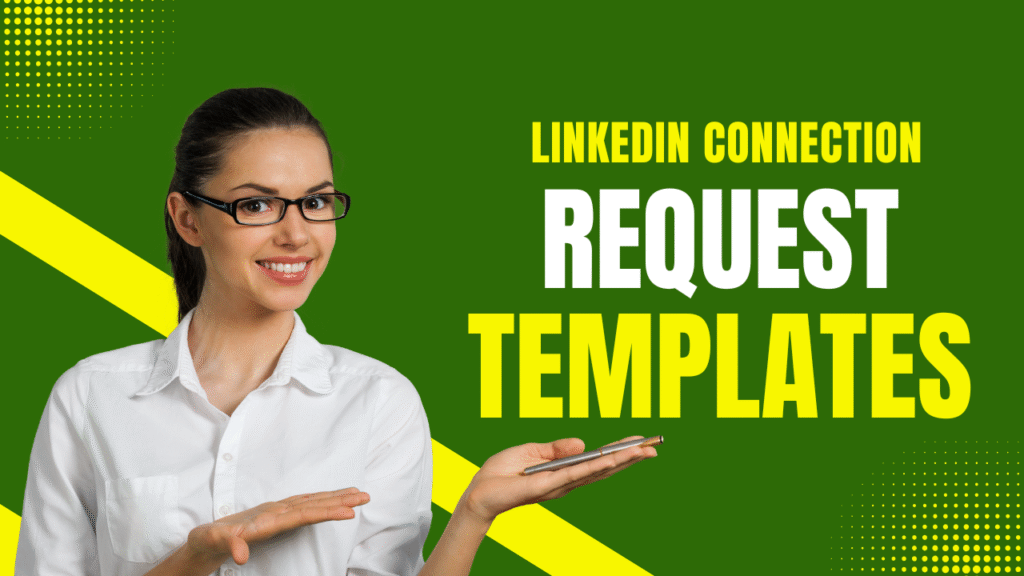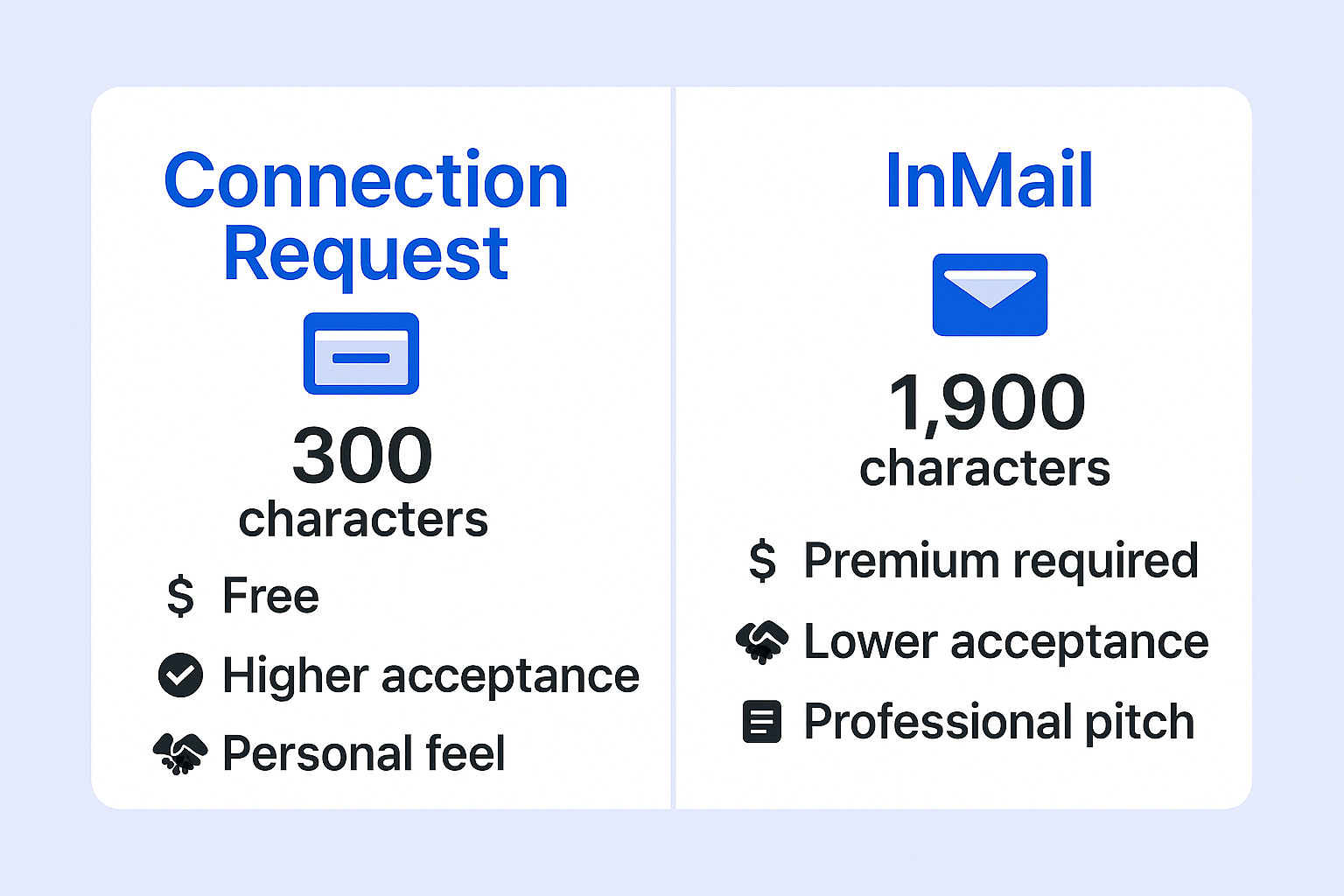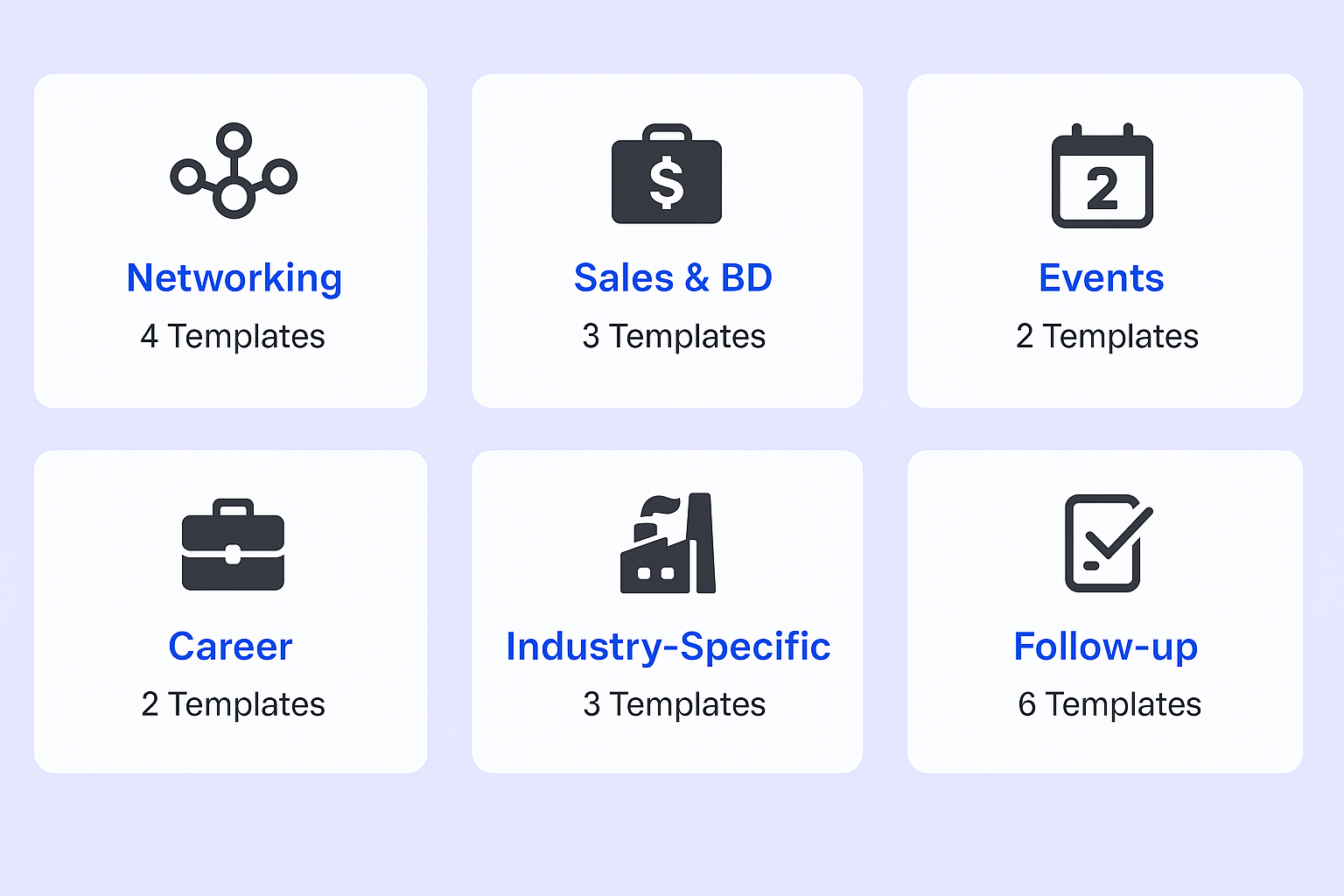- blog
- Lead Generation
- LinkedIn Connection Request Templates | 20+ High-Converting Examples

LinkedIn Connection Request Templates: 20+ High-Converting Templates for Building Professional Networks in 2025
Table of Contents
Introduction: Why Your LinkedIn Connection Request Strategy Matters
Struggling to get your LinkedIn connection requests accepted? You’re not alone. With over 1.15 billion monthly active users on LinkedIn, standing out in someone’s inbox has never been more challenging.
But here’s the thing – 89% of B2B marketers use LinkedIn for lead generation, and those who master the art of connection requests see 277% more effectiveness compared to other social platforms. The secret isn’t in sending more requests; it’s in sending the right ones.
Generic connection requests get ignored. Personalized, value-driven messages get responses. In this guide, we’ll show you exactly how to craft connection requests that prospects actually want to accept, plus the tools that can scale your efforts while keeping them personal.
The Psychology Behind Successful LinkedIn Connection Requests
Before diving into templates, let’s understand what makes people say “yes” to connection requests. Research shows that personalized messages achieve a 45% acceptance rate, compared to just 37% for generic requests.
The 90/10 Rule: The most effective connection requests are 90% about the prospect and only 10% about you. This means focusing on their achievements, interests, or challenges rather than pitching your services immediately.
Timing Matters: Connection requests sent on Monday see 22.04% acceptance rates, followed by Thursday (19.83%) and Wednesday (19.58%). Avoid weekends when acceptance rates drop to just 1.36%.
Connection Requests vs InMail: Understanding the Difference
Many professionals confuse LinkedIn connection requests with InMail messages. Here’s the breakdown:
Connection Requests:
- Limited to 300 characters (including spaces)
- Free to send (with weekly limits)
- Perceived as more authentic and personal
- Higher acceptance rates when personalized
- Creates ongoing relationship potential
InMail Messages:
- Up to 1,900 characters allowed
- Requires LinkedIn Premium or Sales Navigator
- Often perceived as “salesy”
- Can reach anyone, even without connections
- Better for detailed pitches
For most networking and relationship-building purposes, connection requests are more effective because they feel less intrusive and more genuine.
🚀Templates + Strategic Targeting
LinkedIn outbound engine delivers proven frameworks for consistent connection and conversion results
7-day Free Trial |No Credit Card Needed.
20+ High-Converting LinkedIn Connection Request Templates
Networking Templates
Template 1: Mutual Connection Reference “Hi [Name], [Mutual Connection’s Name] suggested I connect with you. I’m exploring [relevant topic] and would value your insights. Looking forward to connecting!”
Template 2: Industry Common Ground “Hi [Name], I noticed we’re both in [industry/field]. Your work at [Company] is impressive. I’d love to connect and exchange insights about [relevant trend].”
Template 3: Content Engagement “Hi [Name], your recent post about [topic] really resonated with me. I’ve faced similar challenges with [specific issue]. Would love to connect and continue the conversation.”
Sales and Business Development Templates
Template 4: Value-First Approach “Hi [Name], I came across an article about [relevant industry challenge] that might interest your team at [Company]. Happy to share if you’d find it valuable. Let’s connect!”
Template 5: Problem-Solution Focus “Hi [Name], I noticed [Company] recently [expansion/change/achievement]. We’ve helped similar companies navigate [related challenge]. Would love to connect and share insights.”
Template 6: Research-Based Outreach “Hi [Name], your background in [specific expertise] caught my attention. I’m working on [relevant project] and would appreciate connecting with industry experts like yourself.”
Event and Conference Follow-ups
Template 7: Post-Event Connection “Hi [Name], great meeting you at [Event Name]. Enjoyed our conversation about [topic discussed]. Let’s stay connected and continue the discussion!”
Template 8: Webinar Engagement “Hi [Name], watched your presentation at [Event/Webinar]. Your insights on [specific topic] were valuable. Would love to connect and learn more about your work.”
Job Search and Career Templates
Template 9: Recruiter Outreach “Hi [Name], I see you recruit for [specific roles] in [industry]. I’m a [your role] with [X years] experience in [relevant skills]. Would appreciate connecting for future opportunities.”
Template 10: Career Transition “Hi [Name], I’m transitioning into [new field/role] and noticed your successful career path in [area]. Would value connecting and learning from your experience.”
Alumni and Educational Connections
Template 11: Alma Mater Connection “Hi [Name], fellow [University] alum here! Noticed your impressive career in [field]. Would love to connect and hear about your journey since graduation.”
Template 12: Course/Certification Connection “Hi [Name], I see we both completed [Course/Certification]. Your background in [field] is impressive. Let’s connect and share insights from our learning experience.”
Industry-Specific Templates
Template 13: Tech/Software “Hi [Name], your work on [specific project/technology] at [Company] is impressive. I’m working on similar challenges in [area]. Would love to connect and exchange ideas.”
Template 14: Marketing/Sales “Hi [Name], saw your recent success with [campaign/strategy] at [Company]. The [specific metric] results were impressive. Would love to connect and learn from your approach.”
Template 15: Consulting/Services “Hi [Name], your expertise in [specific area] would be valuable to my network. I work with companies facing [relevant challenges]. Let’s connect and explore synergies.”
Follow-up and Re-engagement Templates
Template 16: Second Attempt “Hi [Name], following up on my previous request. I believe we could have valuable discussions about [shared interest/challenge]. Would you be open to connecting?”
Template 17: Warm Re-engagement “Hi [Name], it’s been a while since we connected at [previous context]. I’ve been following your work at [Company] and would love to reconnect and catch up.”
Geographic and Location-Based
Template 18: Local Connection “Hi [Name], noticed we’re both based in [City/Region]. Always great to connect with local professionals in [industry]. Would love to expand my network with fellow [location] experts.”
Template 19: Relocation Connection “Hi [Name], I’m relocating to [City] and noticed your successful career there in [industry]. Would appreciate connecting and getting insights about the local market.”
Thought Leadership and Content
Template 20: Thought Leader Engagement “Hi [Name], I consistently find value in your posts about [topic]. Your perspective on [specific issue] has influenced my approach to [relevant area]. Would love to connect.”
Template 21: Podcast/Media Engagement “Hi [Name], enjoyed your recent interview on [Podcast/Show]. Your insights about [topic] were spot-on. Would love to connect and continue following your work.”
📧 Connection Requests That Convert
omplete outreach strategy transforms LinkedIn connections into qualified prospects systematically
Book Strategy Meeting
Best Practices for LinkedIn Connection Requests
Personalization is Non-Negotiable
Every connection request should include at least one personalized element:
- Reference their recent post or article
- Mention a mutual connection
- Acknowledge their company news or achievements
- Reference shared interests or experiences
Keep It Concise and Clear
With only 300 characters available, every word counts:
- Get straight to the point
- Use simple, conversational language
- Avoid jargon or complex terms
- Include a clear reason for connecting
Provide Value Upfront
Instead of asking for something, offer something:
- Share a relevant resource
- Offer insights from your experience
- Provide industry knowledge
- Suggest potential collaboration
Follow the 3-Touch Rule
For important connections, consider this sequence:
- Initial connection request with personalized message
- Thank you message after acceptance
- Value-add follow-up within a week
Common Mistakes to Avoid
Mistake 1: Using Generic Templates Avoid copy-paste messages that could apply to anyone. Always customize based on the prospect’s profile.
Mistake 2: Leading with a Sales Pitch Don’t immediately jump into selling. Focus on building relationships first.
Mistake 3: Sending Too Many Requests LinkedIn limits weekly connection requests. Focus on quality over quantity to maintain good standing.
Mistake 4: Ignoring the Response When someone accepts your request, follow up within 24-48 hours with a thank you message.
Optimizing Your LinkedIn Profile for Better Acceptance Rates
Your profile acts as your credibility check. 95% of prospects will view your profile before accepting your connection request.
Essential Profile Elements:
- Professional headshot (increases profile views by 21x)
- Compelling headline beyond your job title
- Industry-relevant keywords in your summary
- Regular content posting (2-3 times per week)
- Recommendations from colleagues and clients
A complete, optimized profile can increase connection acceptance rates by up to 30%.
🔍 Complete outreach strategy transforms
LinkedIn connections into qualified prospects systematically
Measuring Your Connection Request Success
Track these key metrics to optimize your approach:
Acceptance Rate: Aim for 45% or higher with personalized messages Response Rate: Target 19-25% reply rate to follow-up messages Meeting Conversion: Convert 20-25% of engaged connections to meetings Weekly Connections: Send 20-50 requests per week to avoid limits
Use a simple spreadsheet or CRM to track:
- Date sent
- Template used
- Acceptance status
- Response received
- Meeting scheduled
Advanced Strategies for LinkedIn Success
The Content-First Approach
Before sending connection requests:
- Engage with their content (like, comment meaningfully)
- Share valuable content consistently
- Wait 2-3 days, then send a personalized request
- Reference your previous engagement
This approach increases acceptance rates by 40% because you’re already on their radar.
Multi-Channel Follow-up
After connecting on LinkedIn:
- Send a thank you message on LinkedIn
- Find their email address using tools
- Send a follow-up email with additional value
- Schedule a call or meeting if appropriate
Industry-Specific Timing
B2B Tech: Tuesday-Thursday, 10 AM – 2 PM Healthcare: Monday-Wednesday, 9 AM – 11 AM
Finance: Tuesday-Thursday, 8 AM – 10 AM Marketing: Monday-Friday, 10 AM – 4 PM
Tools to Scale Your LinkedIn Outreach
While manual outreach is important for relationship building, tools can help you scale while maintaining personalization:
LinkedIn Sales Navigator: Advanced search filters and lead recommendations ($99-1600/month) Automation Tools: Dripify, Expandi, WeConnect for sequence automation ($39-150/month) Email Finders: Apollo.io, Kaspr, ContactOut for finding email addresses ($25-99/month) CRM Integration: HubSpot, Salesforce, Pipedrive for tracking relationships
Conclusion
Mastering LinkedIn connection requests isn’t about sending more messages—it’s about sending better ones. The templates and strategies in this guide have helped thousands of professionals build meaningful networks that drive real business results.
Remember the key principles:
- Personalize every message
- Focus on providing value
- Keep messages concise and clear
- Follow up consistently
- Track and optimize your approach
Start with 2-3 templates that fit your industry and goals, customize them for each prospect, and track your results. With consistent effort and the right approach, you’ll see your acceptance rates climb and your professional network expand.
Your next career opportunity, business partnership, or client relationship might be just one connection request away. Make it count.
FAQs
Q1. How does the LinkedIn prospecting tool work?
Q2. How do you get leads with LinkedIn prospecting tools?
Q3. What are the problems that can be solved by LinkedIn prospecting tools?
Q4. When to use LinkedIn prospecting tools?
Salesso – The Best LinkedIn Prospecting Tool
Looking for a comprehensive solution to power your LinkedIn outreach? Salesso combines the best of email finding, verification, and cold outreach in one powerful platform.
Why Choose Salesso:
Find verified email addresses for your LinkedIn connections
Warm up email accounts to improve deliverability
Send personalized cold email sequences at scale
Track opens, clicks, and replies in real-time
Integrate seamlessly with your existing CRM
Perfect for sales teams, marketers, and business owners who want to turn LinkedIn connections into email conversations and ultimately, customers.
Beyond Connection Request Templates
and see why thousands of professionals trust us for their prospecting needs.
7-day Free Trial |No Credit Card Needed.

Beyond Connection Request Templates
Strategic LinkedIn outreach combines personalized messaging with systematic targeting and campaign frameworks
